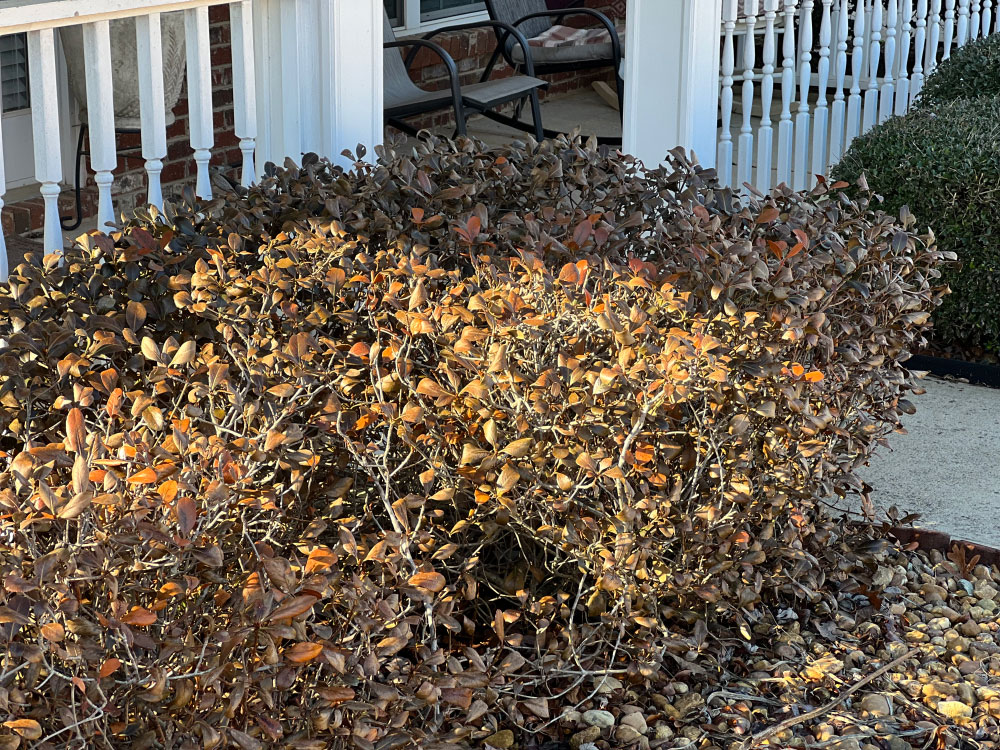Christmas Eve of 2022 and the surrounding days brought some of the coldest temperatures the Atlanta area has experienced in years. Not only did it get freezing cold, but it stayed cold; temperatures barely climbed above freezing for several days in a row. While these conditions aren’t unprecedented, they are certainly unusual. As you see certain plants in your landscape show signs of stress, you may be wondering what is next for each segment of your landscape. Read on to find out more about the current condition and future expectations for your bermuda, zoysia, and fescue lawns as well as your ornamental plants.
Freeze Stress in Fescue
Turfgrasses are divided into groups, and one of the primary splits is between warm-season and cool-season turfs. Although fescue is a cool-season turfgrass, and, as the name suggests, generally performs better in cooler climates, that doesn’t mean fescue is freeze-proof or severe frost-proof. In the days since those single-digit temperatures with ambient air in negative Fahrenheit readings, you may be noticing discoloration in your fescue.
This discoloration is caused by the cells in your grass blades rupturing. Unlike most liquids, water expands when it freezes. That means any moisture in or between the cells that make up your grass blades will expand as it freezes, breaking cell walls in the process. Once the cell walls are ruptured, they are no longer viable. We are now seeing those signs of freeze stress.
Time and patience are key here. Warm afternoon temperatures, sunlight, and warmer soil temperatures will encourage the fescue that survived to begin growing again. In the meantime:
- regular maintenance should continue with care taken not to impart additional damage
- regular mowing to remove debris and any growth is important, but excessive cuts should be avoided.
Did the Freeze Hurt Bermuda or Zoysia Lawns?
Maybe–but maybe not. Bermuda and zoysia lawns were mostly dormant when the deep freeze hit. This is likely to our benefit, but there is no way to know what, if any, damage was done until spring green-up arrives. While the shoots and leaves were already tan, the root systems of these turf species are alive. From these roots and rhizomes, new shoots and leaves will emerge in spring. Hopefully, the roots didn’t sustain significant damage. We will know in a matter of weeks.
Ornamental Trees and Shrubs

Of the plants damaged in this freeze, evergreen trees and shrubs may be the most obvious in your landscape. Plants that are generally hardy may be yellow or have lost their leaves completely since the freeze due to the same inter- and intracellular freezing that happens with fescue. Frost pruning is the terminology used to describe this phenomena in northern states, but it doesn’t regularly happen here.
Much like with our turfgrasses, only time will tell us the full extent of the damage. In the meantime, leave the damaged leaves as a protective measure. They can act as an insulator if we have additional freezes before spring. If you have a plant that appears significantly damaged, refrain from pruning that as well. Hopefully warmer weather will encourage it to create new buds. If a branch becomes dry and brittle, that indicates the plant is no longer supporting that segment. In the event this is true for the entire plant, it may have succumbed completely to the freeze damage.
What Should I Do for My Lawn and Ornamental Shrubs After a Freeze?
Wait. Our landscapes exist in nature and are at the mercy of the weather. After a freeze, it’s important to be patient and wait. For fescue and our ornamental plants, the warmer weather in the weeks following the freeze event will help our plants show signs of life. For our bermuda and zoysia lawns, spring is right around the corner. In any case, Nature’s Turf is available and ready to answer questions and provide the services needed to help your yard recover.
For more information about our programs, services, staff, and resources, give us a call at 678-831-6343 or email us at info@naturesturf.com. We look forward to discussing the ways we can help your landscape recover and exceed the expectations you have for your yard.








